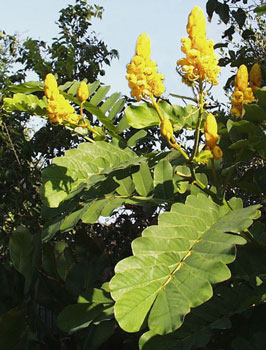Candlestick Plant
Cassia alata
… for tropical towers topped with late summer blooms

Common name: Candlestick Plant
Latin Name: Cassia alata
Design Tip: Make plans for growing this late-summer bloomer early. Set out young candlestick plants into a sunny spot in the middle or back of a mixed border to bloom with fall perennials. Or in tropical designs, the large-scale foliage contributes a texture contrast to elephant ears, tall grasses, banana leaves, caster plants and cannas.
Size and Hardiness: It becomes a massive tree in its native tropics, but is a summer annual in areas with winter weather, rising 8 to 10 feet before ending with first frost.
Flowers: Candelabras of upright racemes open golden blooms for several weeks in late summer and fall, some years lasting up to two months before the first freeze.
Foliage: The massive compound green fronds contribute a tropical element.
Soil: Being a jungle native, it relishes heavy, rich, moist earth.
Light Exposure: It will tolerate part-day sun, but performs better in full sun
Snippets: This is a traffic stopper worth replacing every year. If grown from seed, they need be started as early as January in a warm sunny location, to mature to blooming age before first frost. When its seedpods are frost-nipped in the bud before maturing in the Metroplex climate, it is necessary to plant purchased starts the following year. They are usually available at local nurseries in 4" or 1-gallon size pots in early summer. Botanists have reclassified Cassia alata to Senna alata, but it continues to be marketed as "Cassia" by growers and retailers.
Return to Plant Profiles Index
or
Cultivated, photographed and written
by Maggie Ross McNeely in Fort Worth, Texas
All rights reserved